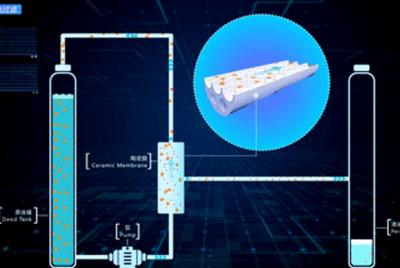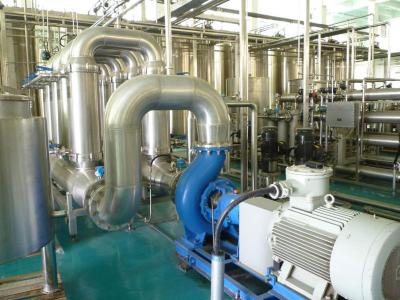Ceramic membrane, also known as inorganic ceramic membrane, is a precision ceramic filter material with porous structure, which is made of alumina, titanium oxide, zirconia, and other high-temperature sintered materials. Its porous support layer, filter layer and microfiltration layer are asymmetrically distributed. The inorganic ceramic membrane separation technology is a material separation technology based on the screening effect of porous ceramic media. It adopts a dynamic "cross flow filtration" method which is different from the traditional "dead end filtration" and “cake filtration”: that is, under the pressure drive, the raw liquid flows at a certain speed on the membrane surface inside the membrane tube, and the small molecular substances (liquids) pass through the microporous membrane along the vertical direction, Macromolecular substances (or solid particles) are intercepted by the membrane, so that the fluid can achieve the purpose of separation, concentration and purification.
1. Ceramic membrane products has been successfully applied in many fields, such as food, beverage, plant deep processing, biomedicine, microbial fermentation, fine chemical industry, etc. it can be used for separation, clarification, purification, concentration, sterilization, desalination, etc. in the process;
2. In the biological fermentation industry: ceramic membrane is widely used in the sterilization, clarification and filtration of penicillin, cephalosporin, erythromycin, colistin sulfate, gibberellin, vancomycin, and other fermentation broth;
3. In the food processing industry: ceramic membrane is widely used in the sterilization, clarification and filtration of tea extract, fruit juice, traditional Chinese medicine extract, oily emulsion wastewater, condiments (soy sauce, vinegar, etc.), wine, draft beer, etc.
1. Ceramic membrane has the advantages of high separation efficiency, good chemical stability, high temperature resistance and good regeneration performance. Generally, the test parameters of the equipment can be linearly amplified;
2. The general flux of ceramic membrane separation is 30-300l/m2h. The specific flux depends on the material viscosity, concentration, and membrane pore size. Generally, the production flux is more than 50l/m2h;
3. The most commonly used ceramic membrane for biological fermentation broth clarification is 50nm or 100nm.
4. Ceramic membrane separation technology is easy to produce concentration polarization, gel polarization, solute adsorption, membrane pore blockage and other phenomena in the filtration process, resulting in membrane pollution. Some measures can be taken to prevent and control the degree of membrane pollution, but membrane pollution can not be completely avoided. Membrane fouling will lead to the increase of filtration resistance and the rapid decline of membrane flux. During the test, the ceramic membrane must be timely treated physically and chemically to restore the membrane flux




 +86-25-58849045
+86-25-58849045
 +86-25-58749295
+86-25-58749295
 jiuwu@jiuwu.com
jiuwu@jiuwu.com
 No. 9 Park Road, Pukou District, Nanjing City (Sanqiao Factory)
No. 9 Park Road, Pukou District, Nanjing City (Sanqiao Factory) Call us on:
Call us on:  Email Us:
Email Us:  No. 9 Park Road, Pukou District, Nanjing City (Sanqiao Factory)
No. 9 Park Road, Pukou District, Nanjing City (Sanqiao Factory)

 English
English 한국어
한국어 français
français русский
русский Español
Español

